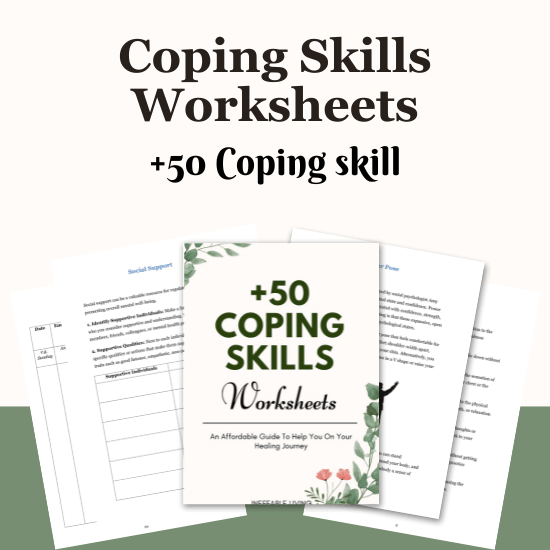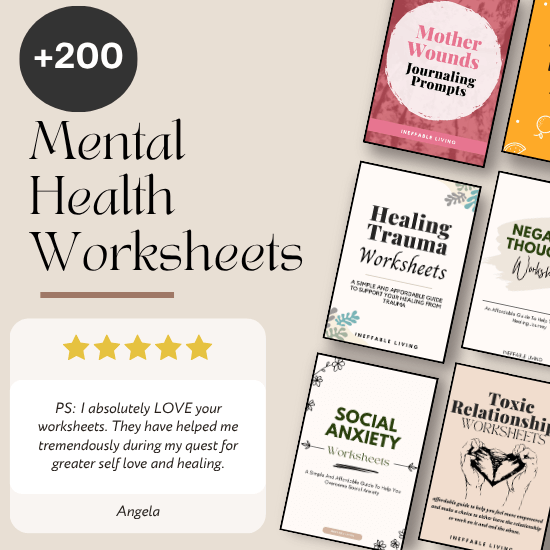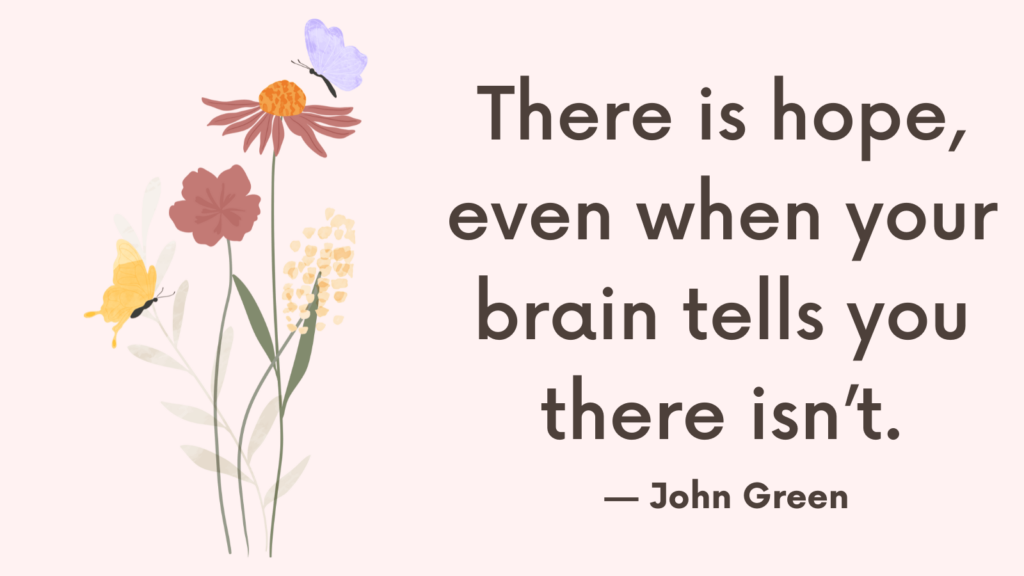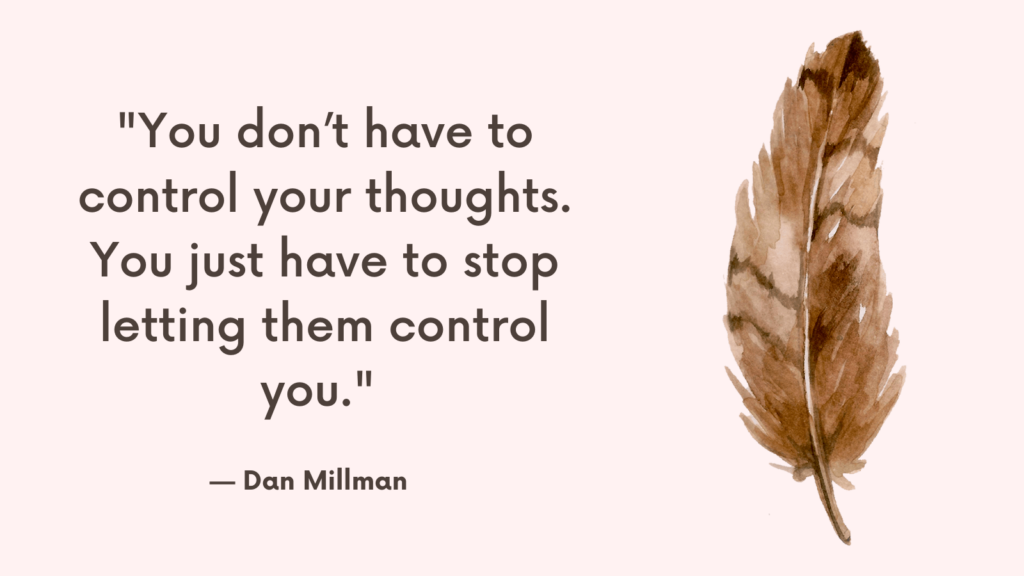Therapy offers practical tools for managing stress, regulating emotions, and navigating life’s challenges. These coping skills aren’t about avoiding pain but about building resilience and giving yourself healthier ways to handle it.
Cognitive Behavioral Therapy (CBT)
CBT helps people notice unhelpful thoughts, challenge them, and replace them with more balanced ones. It connects thoughts, feelings, and behaviors to break negative cycles.
Catch and Challenge a Negative Thought
- Notice the automatic negative thought as it appears.
- Write it down exactly as it came to mind.
- Ask yourself: “What evidence supports this thought?”
- Ask yourself: “What evidence goes against it?”
- Replace it with a more realistic, balanced version.
Objective: Reduce the power of distorted thinking by testing it logically.
Thought Record Exercise
- Identify a triggering situation and describe it briefly.
- List the automatic thoughts that came up.
- Note the emotions you felt and rate their intensity.
- Identify which cognitive distortions may be present (e.g., all-or-nothing, catastrophizing).
- Reframe the thought into a more balanced perspective.
Objective: Increase awareness of thought-emotion links and shift perspective.
Behavioral Activation Scheduling
- Make a list of small activities that usually give you energy or joy.
- Choose one or two to commit to for the day.
- Write down when you will do them and for how long.
- Follow through, even if motivation is low.
- Reflect afterward on how your mood changed.
Objective: Reduce withdrawal and improve mood through action.
Worst-Case, Best-Case, Most Likely Scenario
- Identify a current worry or fear.
- Write out the absolute worst-case scenario in detail.
- Write out the best-case scenario, even if it feels unrealistic.
- Write out the most likely outcome, based on facts.
- Compare all three and notice how your perspective shifts.
Objective: Balance catastrophic thinking with perspective.
Evidence Collection Journal
- Identify a recurring negative belief (e.g., “I’m a failure”).
- Each day, write down evidence that supports this belief.
- Also write down evidence that contradicts it.
- At the end of the week, review both sides.
- Ask yourself: “What feels truer now?”
Objective: Weaken rigid negative beliefs with real-life evidence.
Graded Exposure to Fears
- Make a “fear ladder,” from least scary situation to most.
- Start with the easiest item on your ladder.
- Expose yourself gradually until anxiety decreases.
- Move up to the next step when ready.
- Continue until you reach the top of the ladder.
Objective: Reduce avoidance by teaching the brain that feared situations are survivable.
Daily Thought Replacement Practice
- Identify one repeating unhelpful thought.
- Choose a balanced statement to replace it with.
- Each time the thought appears, consciously swap it with the new one.
- Track how often this happens throughout the day.
- Reflect on any changes in emotion or behavior.
Objective: Build consistent self-supportive thinking.
Cost-Benefit Analysis of a Thought
- Pick a negative thought that lingers.
- List the benefits of holding onto it.
- List the costs of continuing to believe it.
- Compare both sides clearly.
- Decide whether keeping this thought serves your well-being.
Objective: Create clarity about whether a thought is worth holding.
Daily Cognitive Reframing Journal
- At day’s end, write down three stressful or emotional moments.
- For each, list the automatic thought that came up.
- Identify the distortion behind it.
- Reframe the thought into something more balanced.
- Reflect on what you learned about your thinking patterns.
- Objective: Train your mind to consistently reframe negativity.
Socratic Questioning
- Write down a troubling thought.
- Ask: “What evidence do I have for this thought?”
- Ask: “Is there an alternative explanation?”
- Ask: “What would I say to a friend who had this thought?”
- Ask: “Will this matter a week, a month, or a year from now?”
Objective: Challenge rigid thinking through structured questioning.
Decatastrophizing Exercise
- Notice when you’re imagining the worst outcome.
- Ask: “What is the absolute worst that could happen?”
- Ask: “How likely is this to occur?”
- Ask: “If it did happen, how would I cope with it?”
- Write a balanced statement that includes your ability to handle it.
Objective: Reduce exaggerated fear and bring situations into perspective.
Identify Thinking Errors
- Write down a stressful thought.
- Compare it to a list of common distortions.
- Identify which distortions apply.
- Rewrite the thought without them.
Objective: Increase awareness of distorted thinking and correct them.
Activity-Mood Log
- Create two columns: Activities and Mood (0–10 scale).
- Throughout the day, record what you’re doing and how you feel.
- At day’s end, review for patterns.
- Use this to schedule more uplifting activities.
Objective: Strengthen awareness of how behavior influences mood.
Coping Cards
- Write one recurring negative thought on an index card.
- On the other side, write a rational counter-thought.
- Carry it with you and read when the thought appears.
- Build a collection of cards over time.
Objective: Provide quick access to reframed thoughts in real time.
Pie Chart of Responsibility
- Write down a situation where you blame yourself completely.
- Draw a circle and divide it into “slices.”
- Assign responsibility to all factors involved.
- Compare your slice to the full picture.
Objective: Relieve excessive self-blame with balanced responsibility.
Reattribution Exercise
- Write down something negative you’re blaming yourself for.
- List other contributing factors: people, circumstances, timing.
- Reassign responsibility fairly among them.
Objective: Reduce self-blame and build realistic understanding.
Positive Data Log
- Each day, record three positive events or accomplishments.
- Include both big and small wins.
- Re-read them at the end of the week.
Objective: Train the brain to notice successes instead of failures.
Successive Approximation
- Choose a difficult goal you’ve been avoiding.
- Break it into the smallest possible step.
- Complete that step and reward yourself.
- Gradually add bigger steps until the full goal is met.
Objective: Build confidence and reduce procrastination gradually.
Self-Monitoring of Triggers
- Carry a notebook or app.
- When strong emotions arise, record the situation, thought, and feeling.
- Review entries weekly for patterns.
- Use these insights to plan healthier responses.
Objective: Build self-awareness of triggers and thinking habits.
Thought Stopping
- When a repetitive thought appears, firmly say “Stop.”
- Replace it with a calming word or image.
- Repeat as needed to interrupt rumination.
Objective: Break cycles of intrusive thinking.
Reframing Setbacks as Learning
- When something goes wrong, write down the event.
- Write what you learned from it.
- Write how you can apply that lesson moving forward.
Objective: Turn setbacks into opportunities for growth.
Behavioral Experiment
- Identify a negative prediction you hold.
- Plan a safe way to test it.
- Record what actually happens.
- Compare predicted vs. real outcomes.
Objective: Weaken fears through real-world testing.
Dialectical Behavior Therapy (DBT)
DBT blends cognitive-behavioral tools with mindfulness and acceptance practices. It focuses on four core skill areas: distress tolerance, emotion regulation, interpersonal effectiveness, and mindfulness.
STOP Skill
- Stop what you’re doing immediately.
- Take a step back physically or mentally.
- Observe your thoughts, feelings, and surroundings.
- Proceed mindfully with intention rather than impulse.
Objective: Prevent impulsive reactions and create space for wise decision-making.
TIPP Skills (Temperature, Intense Exercise, Paced Breathing, Progressive Relaxation)
- Change your Temperature: splash cold water on your face or hold ice.
- Do short bursts of Intense Exercise to burn off stress.
- Practice Paced Breathing: inhale for 4, exhale for 6.
- Use Progressive Relaxation to tense and release muscles.
Objective: Quickly calm the body’s stress response and regulate emotions.
Self-Soothe with the Five Senses
- Use sight: look at calming images or nature.
- Use sound: listen to soothing music or white noise.
- Use smell: light a candle or use essential oils.
- Use taste: drink tea or eat something comforting slowly.
- Use touch: hold a soft blanket, squeeze a stress ball.
Objective: Ground yourself by using sensory experiences for comfort.
Wise Mind Practice
- Notice your Emotion Mind: driven only by feelings.
- Notice your Reasonable Mind: driven only by logic.
- Blend the two into Wise Mind: balanced, centered, intentional.
- Pause before acting and ask: “What would Wise Mind do?”
Objective: Make decisions that integrate both emotion and reason.
Radical Acceptance
- Acknowledge the reality of a painful situation.
- Remind yourself: “This is the way it is right now.”
- Release the urge to fight against what you cannot change.
- Focus energy on what you can control.
Objective: Reduce suffering by accepting reality instead of resisting it.
Opposite Action
- Identify the emotion you feel and the urge it creates.
- Ask: “Does this urge fit the facts of the situation?”
- If not, do the opposite of the urge (e.g., approach instead of avoid).
- Stay consistent until the emotion shifts.
Objective: Break harmful behavior cycles driven by intense emotions.
PLEASE Skill (Treat Physical Illness, Eat Healthy, Avoid Mood-Altering Substances, Sleep, Exercise)
- Take care of physical illness by following medical needs.
- Eat balanced meals instead of skipping or overeating.
- Avoid drugs and alcohol that worsen mood swings.
- Get regular sleep for energy and stability.
- Exercise moderately to regulate mood.
Objective: Prevent vulnerability to emotional crises by caring for the body.
Improve the Moment (IMPROVE)
- Imagery: visualize a peaceful place.
- Meaning: find purpose in the situation.
- Prayer: connect with spirituality or values.
- Relaxation: use breathing or warm baths.
- One thing at a time: focus on the present.
- Vacation: take a brief mental or physical break.
- Encouragement: use positive self-talk.
Objective: Cope with distress by changing your mindset or environment.
Half-Smile and Willing Hands
- Relax your face and form a gentle half-smile.
- Place your hands open, palms up, resting in your lap.
- Hold this posture while breathing calmly.
Objective: Influence mood through intentional body posture.
Mindfulness of Current Emotion
- Identify the emotion you’re feeling right now.
- Allow yourself to fully experience it without judgment.
- Notice where it shows up in your body.
- Let it rise, peak, and pass naturally.
Objective: Reduce fear of emotions by mindfully experiencing them.
GIVE Skill (Gentle, Interested, Validate, Easy Manner)
- Be Gentle in your tone and words.
- Show Interest by listening fully.
- Validate the other person’s feelings.
- Use an Easy Manner (humor, lightness, warmth).
Objective: Strengthen relationships while being kind and effective.
FAST Skill (Fair, Apologies, Stick to Values, Truthful)
- Be Fair to yourself and others.
- Avoid unnecessary Apologies.
- Stick to your values instead of people-pleasing.
- Stay Truthful and avoid exaggeration.
Objective: Maintain self-respect in relationships.
DEAR MAN Skill (Describe, Express, Assert, Reinforce, Mindful, Appear Confident, Negotiate)
- Describe the situation objectively.
- Express how you feel about it.
- Assert what you need clearly.
- Reinforce by explaining benefits of meeting your need.
- Stay Mindful and focused on your goal.
- Appear Confident in voice and body.
- Negotiate if compromise is needed.
Objective: Communicate effectively to meet your needs while respecting others.
Urge Surfing
- Notice the urge to act on an emotion (e.g., yelling, self-harm, binge eating).
- Imagine it as a wave rising and falling.
- Breathe and ride the wave without acting.
- Watch the urge decrease naturally over time.
Objective: Build tolerance for urges without giving in.
Willingness vs. Willfulness
- Notice when you resist reality with willfulness (“This shouldn’t be happening”).
- Shift into willingness: openness to doing what the situation requires.
- Remind yourself: “I don’t have to like it, but I can face it.”
Objective: Build resilience by cooperating with reality instead of fighting it.
Build Positive Experiences
- Plan small enjoyable activities each day.
- Include both short-term (a walk, music, cooking) and long-term (learning, relationships).
- Track and reflect on how these boost your mood.
Objective: Increase emotional resilience by filling life with positivity.
Accumulate Positive Emotions
- Identify activities, people, or goals that bring joy.
- Add more of these consistently into your schedule.
- Let yourself fully experience positive moments without rushing.
Objective: Strengthen your baseline mood over time.
Acceptance and Commitment Therapy (ACT)
ACT focuses on accepting thoughts and feelings without judgment, connecting with values, and committing to actions that align with those values. Its core processes are acceptance, defusion, mindfulness, values, and committed action.
Leaves on a Stream Visualization
- Sit quietly and close your eyes.
- Imagine sitting by a stream, watching leaves float past.
- Place each thought that arises onto a leaf and watch it drift away.
- Let new thoughts come and repeat the process without judgment.
Objective: Create distance from thoughts instead of getting stuck in them.
Thanking Your Mind Exercise
- When a difficult thought arises, say: “Thanks, mind, for that thought.”
- Repeat it warmly, as if you’re acknowledging an old habit.
- Notice how this reduces the thought’s control over you.
Objective: Defuse from thoughts by treating them as mental events, not truths.
The Chessboard Metaphor
- Imagine your mind as a chessboard.
- Thoughts and feelings are pieces (black vs. white) fighting each other.
- You are not a piece — you are the board, holding them all.
Objective: Develop perspective-taking by realizing you are the observer of thoughts, not the content.
Passengers on the Bus Metaphor
- Picture yourself driving a bus.
- Your thoughts and feelings are noisy passengers demanding control.
- Stay focused on your direction (your values), even if the passengers keep talking.
Objective: Stay committed to values even when difficult thoughts arise.
Defusion Through Silly Voices
- Take a negative thought and repeat it in a silly voice (like a cartoon).
- Repeat it several times until it loses intensity.
- Notice how it feels different from before.
Objective: Reduce the believability of painful thoughts.
Values Clarification
- List areas of life: family, career, health, spirituality, relationships.
- Ask: “What do I want to stand for here?”
- Write down values for each domain.
Objective: Identify guiding principles to direct meaningful action.
Bullseye Values Exercise
- Draw a dartboard with your values in the center.
- Mark where you currently stand in living those values.
- Reflect on areas where you want to move closer to the center.
Objective: Increase awareness of how aligned your actions are with your values.
Committed Action Planning
- Choose one value you want to live more fully.
- Write down one small action that supports this value.
- Schedule it into your day or week.
- Review progress regularly.
Objective: Turn values into consistent behaviors.
Expansion Exercise
- Notice a difficult feeling in your body.
- Breathe into it and make space around it instead of pushing it away.
- Imagine the feeling expanding and having room to move.
Objective: Increase emotional acceptance and reduce avoidance.
80th Birthday Reflection
- Imagine yourself at your 80th birthday.
- Picture what you want people to say about your life.
- Write down the values that show up in their words.
Objective: Clarify values by looking at what truly matters in the long run.
Willingness vs. Avoidance Check
- Identify a thought or feeling you’ve been avoiding.
- Ask: “Am I willing to have this experience if it helps me move toward my values?”
- If yes, notice the willingness and take one small step.
Objective: Build flexibility by choosing values over avoidance.
Life Compass Exercise
- Imagine your life as a journey with a compass.
- Values are the compass directions (north, south, east, west).
- Goals are destinations, but the compass always guides your path.
Objective: Stay values-oriented instead of outcome-obsessed.
Self-as-Context Practice
- Sit quietly and imagine your thoughts and feelings as clouds.
- Notice that no matter how stormy they get, the sky (your observing self) remains.
Objective: Strengthen awareness of self beyond experiences.
Choice Point Exercise
- Identify a difficult situation.
- Ask: “Is this choice moving me toward my values or away from them?”
- Choose the toward-action, even if uncomfortable.
Objective: Simplify decisions by linking them to values.
Pain vs. Suffering Distinction
- Write down a recent painful event.
- Separate the facts (pain) from the added struggle (judgments, “this shouldn’t happen”).
- Notice how suffering decreases when you focus only on the facts.
Objective: Accept pain while reducing unnecessary suffering.
Art Therapy
Art therapy uses creative expression to help process emotions, release tension, and explore inner experiences. The goal is not artistic talent but self-expression and healing.
Doodle Without Purpose for 3 Minutes
- Take a blank sheet of paper and pen or pencil.
- Let your hand move freely without planning or control.
- Allow shapes, lines, and scribbles to appear.
- Stop after 3 minutes and notice what feelings came up.
Objective: Release mental pressure through spontaneous creative flow.
Color Your Emotions
- Choose a current emotion you’re feeling.
- Pick colors that represent it (e.g., red for anger, blue for sadness).
- Fill a page with shapes, lines, or patterns in those colors.
- Reflect on how the image matches your inner state.
Objective: Increase emotional awareness by giving feelings a visual form.
Draw Your Safe Place
- Imagine a place where you feel completely calm and safe.
- Draw it in as much detail as possible.
- Add colors, textures, or symbols that bring peace.
- Keep the drawing as a grounding tool to revisit.
Objective: Build an inner sense of safety and comfort.
Create an Emotion Wheel
- Draw a large circle and divide it into slices.
- Label each slice with a different feeling (anger, joy, fear, calm).
- Use colors, textures, and shapes to represent each one.
- Notice which emotions take up more space for you today.
Objective: Expand emotional vocabulary and awareness through art.
Collage of Strengths
- Collect magazines, newspapers, or printouts.
- Cut out images, words, or colors that reflect your strengths.
- Arrange and glue them into a collage.
- Reflect on what the collage says about your resilience.
Objective: Boost self-esteem by visualizing strengths.
Draw a Timeline of Your Life
- Draw a line across the page to represent your life so far.
- Use colors, symbols, or small drawings to mark key moments.
- Notice themes of struggle, growth, and resilience.
- Add hopeful future symbols at the end.
Objective: Reflect on personal growth and life journey visually.
Nature Collage
- Go outside and collect natural items (leaves, twigs, flowers).
- Arrange them on paper or canvas to create an image.
- Notice textures, shapes, and colors as you work.
- Reflect on the sense of grounding nature provides.
Objective: Reduce stress and reconnect with the natural world.
Somatic Therapy
Somatic therapy focuses on the connection between mind and body. It helps release stored tension, regulate the nervous system, and restore balance through movement, breath, and body awareness.
Grounding Through the Feet
- Stand tall with feet firmly on the ground.
- Shift weight slowly from heels to toes.
- Notice textures, pressure, and sensations under your feet.
- Imagine roots growing from your feet into the earth.
Objective: Increase grounding and stability in the body.
Orienting to Safety
- Look slowly around your environment.
- Identify 5 things you see, 4 things you hear, 3 things you feel, 2 things you smell, 1 thing you taste.
- Notice signs of safety in the room (walls, floor, secure objects).
Objective: Calm the nervous system by reminding it of present safety.
Butterfly Hug
- Cross arms over your chest with fingertips on your shoulders.
- Tap your shoulders alternately, left then right.
- Breathe slowly as you continue tapping for a few minutes.
Objective: Reduce distress and increase calm through bilateral stimulation.
Shake It Out Exercise
- Stand with feet shoulder-width apart.
- Begin shaking your hands, arms, shoulders, and legs.
- Let the whole body shake for 1–2 minutes.
- Pause and notice the sensations afterward.
Objective: Release stored stress and reset the nervous system.
Tension and Release
- Tense a muscle group (hands, shoulders, legs) for 5 seconds.
- Release completely and notice the difference.
- Move through several areas of the body.
Objective: Recognize and release physical tension.
Safe Touch with Objects
- Hold a comforting object (pillow, blanket, stone).
- Notice its texture, weight, and temperature.
- Press it gently against your chest or hold in your hands.
Objective: Provide sensory grounding and self-soothing.
Cold Water Reset
- Splash cold water on your face or hold an ice pack to your cheeks.
- Breathe deeply as the coolness activates your body.
- Notice how alertness and calm emerge.
Objective: Quickly regulate the nervous system during overwhelm.
Related: 10 Most Common Unhealthy Coping Mechanisms (And How to Replace Them)

Conclusion
Coping skills from therapy aren’t about never struggling—they’re about having tools to lean on when life feels heavy. By grounding yourself, reframing thoughts, naming emotions, and practicing self-compassion, you create space to move through challenges with more strength and balance.



